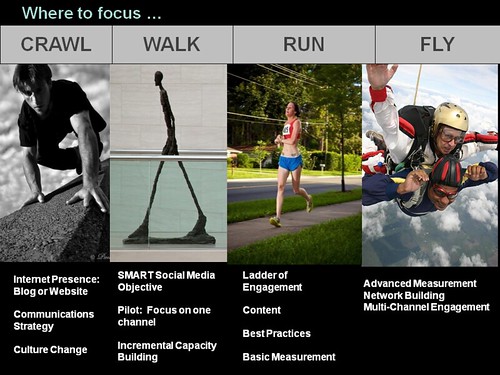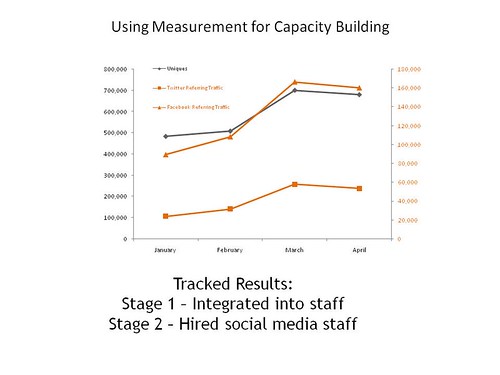Part of my work as Visiting Scholar at the David and Lucile Packard Foundation is facilitating several peer learning groups on social media measurement. The intent is to help grantees improve their social media practice through measurement and learning. It is also serving as a focus group, producing deep insights and stories for my next book on social media measurement, Measuring the Networked Nonprofit, that I’m co-authoring with goddess of measurement, KD Paine.
I’m a big fan of taking baby steps for social media, measuring social media, or any new process or skill you’re trying to introduce in your organizations. For most organizations, resources are limited – anything that requires too much bandwidth to be successful initially or too much – won’t be successful. As a nonprofit technology trainer for the past 15 years, ” baby steps” approach is extremely important for adoption of new practices. While early adopters want and can go at warp speed, there is absolutely nothing wrong with taking an incremental, slower approach.

Ask: What Area Practice Do We Want To Improve?
I’ve developed a maturity of social media practice model called “Crawl, Walk, Run, Fly.” I have used this to design peer learning programs, develop curriculum, and work one-on-one with organizations – here in the US and in places around the world. The model works well because it helps organization identify incremental improvements and build their capacity. We started with doing the assessment in the social media measurement peer group to answer these three questions:
- What level of social media practice is your nonprofit?
- What’s needed for improvement?
- What social media measurement pilot can best help move your practice forward?
B0nus Insight: Linking Social Media Results to Job Performance
The model prompted a fantastic discussion about practice. Going from “Walking to Running” requires more capacity to implement social media and to ensure adoption it needs to be linked to job performance. Debbie Ford-Scriba from the American Leadership Forum mentioned, “Our numbers when up when we integrated social media tasks into staff job descriptions AND linked to job performance.” The organization worked with an agency that helped them developed a robust communications strategy that included best practices in branding and messaging, measurable objectives, identified audiences based on research and social media scanning, a marketing funnel/model, and best practices in multiple channels. However, they could only go so far with having social media as part of one person’s job, so they encouraged all staff to participate. It was far easier to say that the organization was going to integrate social media into everyone’s job than it actually having it happen.
It wasn’t until recently that the organization started to make real progress on their strategy. Since this is an organization that has data-driven decision-making in its DNA, they review their reports. Next, they had a session with senior staff, taking them through why it was important to build capacity and what might result from the investment. It wasn’t just about the numbers that convinced the leadership, it was tying the use of social media and an integrated strategy to their organizational outcomes — their mission. Senior leadership suggested linking results to staff job performance.
Providing staff training is essential. Dave Taylor from the Rainforest, shared that they got staff buy-in by creating 3 month program called “Web Wednesdays.” Every other Wednesday, they bought lunch for staff and did hour long trainings. The content was on all channels, not just social media. They had different levels, from basic introductions to more advanced topics. In addition to group trainings, they also did a lot of one-on-one sessions with everyone, including senior leadership. Dave Taylor says the secret to success was using their own examples. “If we did a session Twitter, we’d share our best and worst tweets and why.” It is important to note that the training effort was 20% of their department’s annual work plan. This has paid off for them because when they ask staff to Tweet, share campaign links via email, or other channels – it sweeps right through and out of the organization to their networks.
This prompted a question from Alison Carlson (Global Giving’s “Un Marketing Manager”) – Should you tie results to job performance review if staff person is using their personal account? (Now being discussed over here)
Picking A Social Media Measurement Pilot
In KD Paine’s book “Measure What Matters,’ she advises starting with test project because implementing a full-blown measurement program can be daunting. This is especially true for nonprofits. How do you pick a good pilot? Select something that is:
- A priority in the work plan
- Keeps the executive director or board up at night
- An area of social media practice that needs improvement

Many organizations want to use social media media measurement to help pave the way for organizational adoption and document the value of social media to reach stated objectives. The chart above is a small example of how GRIST tracked its results on a campaign against staff investment. The first stage was to look at increases in metrics if all staff added social media tasks to their jobs. This gave them the confidence to invest in a social media staff person and they saw more results. (Case study is here)
Watch Out for Office Politics

Organizational culture issues related to social media measurement may be slightly different than those around social adoption in general which tend to focus on concerns around privacy, sharing control of branding/messaging, and the line between personal and organizational. KD Paine points out in her book that a measurement project may step on someone’s toes and there will be push back. She offers a process for getting started picking a measurement pilot:
1. Understand background
2. Assemble Team
3. Have a meeting to discuss what success and failure looks like
4. Brainstorm objectives
5. Vote on the most important
It is really important to get everyone’s input, not to silo this selection process in one department. Involve senior staff as well as program and policy staffers. And, if you end up with two choices that rise to the top go for the easy win, if one is more complicated than the other. It may also be necessary to think about this pilot as “R&D”.
Examples of Social Media Measurement Pilot Projects
Here’s some examples of some initial thinking on social media measurement pilots:
- Benchmark/Best Practices Study: A cluster of advocacy organizations are working together on a statewide initiative to protect coast areas in California. They want to gather benchmarks for social media use of all partners and do interviews to learn about best practices for integrated campaigns. This will be used to set objectives for a networked approach.
- Design Cross-Department Dashboard: Social media has been integrated into communications strategy of different departments – and not every department is consistently collecting data or looking at a high level report of KPIs. This project would look at designing an automated dashboard that could be shared across departments.
- Develop Ladder of Engagement Model w/Metrics for a specific campaign or event: For example, one organization is implementing a month-long campaign to encourage people not to use plastic bags. The campaign will have a mini site, merchandise, organizational membership options, etc. The organization will clarify its ladder of engagement and identify metrics to test what channels/messaging work best to move people through the ladder.
- Blog Redesign: As a prelude for expanding a blog to multiple departments and new redesign, to analyze what content performs the best with audiences to engagement and for conversions.
- Staff Buy-In Project: To document the results of a small project or campaign to share with staff in a road show to generate buy-in for fuller participation.
Has your organization taken some baby steps with measurement and social media by doing a pilot? What was your pilot? What challenges did you encounter? What did you learn?
